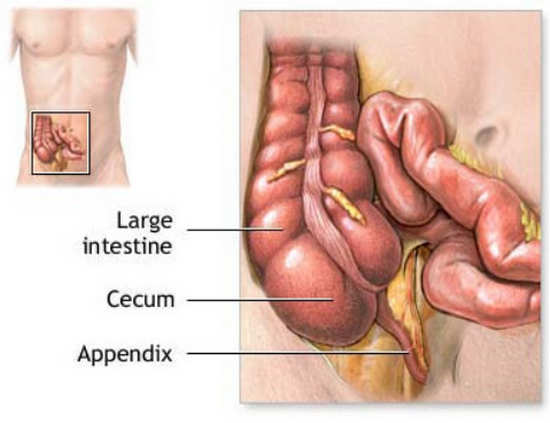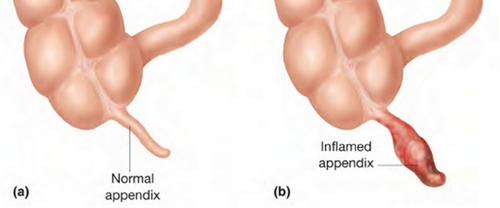Appendix
Last reviewed by Dr. Raj MD on January 12th, 2022.
What is appendix
The appendix is a thin tube that is about four inches long. The appendix location is in the lower right abdomen. It is attached to the large intestines. In the medical field, it is called vermiform appendix.
Where is your appendix located
The appendix is located in the lower right side of the abdomen. It looks like a narrow tube-shaped pouch that protrude from the large intestine. It is connected to the caecum and about four inches in length and a pencil-thin.
It consists of an inner layer of mucosa and surrounded by submucosa, serosa, and muscularis layers. It contains masses of lymphoid tissue. The appendix is a vestigial organ, which means that a person can live a normal life even without the appendix.

Picture 1 : Appendix location

Picture 2 : Appendix pain location (appendicitis) – Mc Burneys point

Picture 3 : Appendix various positions (anatomical variants)
What is the function of the appendix?
- It plays an important role in the fetus and young adults. At around 11th week of fetal development, the endocrine cells of the appendix produce biogenic amines and peptide hormones, which help with biological control mechanisms.
- Appendix function in the digestive system is to produce and protect beneficial probiotics in the gut. It acts as a reserve for good bacteria.
- Appendix functions as a lymphoid organ, which assist B lymphocyte maturation and aid in the production of immunoglobulin A antibodies.
- The appendix plays a vital role in the production of molecules, which helps direct the movement of lymphocytes to various parts of the body.
- The appendix improves the body’s physiologic immune response, especially in controlling food, drug, and microbial antigens. (1, 2, 4, 8)
Appendix Conditions
For some reasons, the appendix can become inflamed. If not managed carefully, it could get severely infected and could lead to rupture of the appendix. Appendix problems symptoms include severe pain in the right lower quadrant of the abdomen, nausea and vomiting. Inflammation of the appendix is called appendicitis.
It is a medical emergency and requiring prompt surgery. If the problem is left untreated, it could lead to perforation of the appendix. It will spill infectious materials into the abdominal cavity. The lining of the abdominal cavity will be inflamed. The toxic materials will travel to various parts of the body. This can be fatal and could lead to death if not taken seriously. (2, 3, 5)

Image 1: An image of comparison between a healthy appendix and an inflamed appendix.
Picture Source: www.healthresource4u.com
 Photo 2: A step by step procedure on how to do a laparoscopic appendectomy
Photo 2: A step by step procedure on how to do a laparoscopic appendectomy
Image Source: image.slidesharecdn.com
Appendicitis symptoms
- Appendix pain symptoms are characterized as dull. The pain is felt near the navel or on the upper abdomen. As it moves to the lower right quadrant of the abdomen, the pain becomes sharp in nature.
- Nausea
- Loss of appetite (6)
- Abdominal swelling along with vomiting
- High grade fever
- The patient is unable to pass gas
- Pain when urinating
- Constipation
- Severe cramps
Diagnosis
It is quite difficult to diagnose appendicitis because its symptoms are similar to that of other diseases. To come up with an accurate diagnosis, various procedures need to be done such as urinalysis to rule out urinary tract infection, abdominal exam to check for signs of inflammation, rectal exam, CT scan or ultrasound of the abdomen, and blood test to check for infections. (6, 8)
It is necessary to remove a healthy appendix?
Before, when doctors perform abdominal surgeries, they routinely remove the appendix to prevent the possibility of appendicitis. However, today the appendix is spared because it plays an important role in the reconstructive surgery just in case the urinary bladder is removed. The appendix is used to re-create a sphincter muscle, which controls the person’s ability to control urine. The appendix can also be used to replace a damaged ureter thereby helping the urine to flow from the kidneys to the bladder. In other words, the appendix is useful in performing various reconstructive surgical procedures. A healthy appendix is saved for future use. (7, 9)
How to treat problems concerning the appendix?
If the doctor is suspecting problems concerning the appendix, the patient will usually be put on antibiotics to address any potential infections. However, the antibiotics can only treat the symptoms. It will not effectively treat appendicitis. An appendectomy, surgical removal of the appendix is the only way to treat appendicitis.
The primary reason why the appendix is removed is to avoid bursting of the appendix. If there is abscess in the appendix, it should be drained first and will then be removed after a particular period of time. (10)
How do you know if your appendix burst?
There are signs telling you that your appendix is about to burst. These are the following:
- Severe abdominal pain – You are suffering from extreme pain in the stomach. The pain extends from the belly button going to the lower right side quadrant of the abdomen. If you complain of severe abdominal pain, the doctor will request for an imaging test such as CT scan to detect the condition of the appendix.
- Nausea with or without vomiting – Not everyone with appendicitis experience nausea and vomiting. If you are feeling really queasy, then you have to contact your doctor right away. An inflamed appendix can sometimes affecting the gastrointestinal tract as well as the nervous system, which explains why you are suffering from nausea and vomiting.
- Frequent urination – If you are running to the bathroom more than the usual, it could be a probable sign that your appendix is about to burst. The appendix is just right below the pelvis, which makes it close to the bladder. When the appendix gets inflamed, there is a possibility that it will get in contact with the bladder. It is the reason why you feel like peeing most of the time. In fact, it could also lead to inflammation of the bladder causing the urination process to be painful. Initially, you feel like you are having a urinary tract infection. Further studies need to be conducted to rule out the root cause of the problem.
- Fever and chills – Fever along with chills are the first warning signs that there is something wrong in your body. If the appendix is inflamed, the body will cope with the inflammation by releasing chemicals to send information to the fighter cells of the body. As a response, the body will manifest symptoms like fever, chills, and localized pain.
- Confusion and disorientation – These are the signs that the infection in the body is getting worse. It could indicate that the infection has entered the bloodstream or medically known as sepsis. This condition can be very fatal. It can severely affect the functions of the body and the level of oxygen in the blood will be reduced significantly. As a result, the brain will not receive ample amount of oxygen leading to symptoms like anxiety, confusion, and disorientation. If the patient is suffering from these symptoms, you should immediately go to the hospital. (3, 5 7, 8, 10)
References:
- www.webmd.com
- https://en.wikipedia.org
- www.medicinenet.com
- www.healthline.com
- www.prevention.com
- www.onhealth.com
- www.health.com
- www.innerbody.com
- www.everydayhealth.com
- Appendicitis By W. H. Bowen